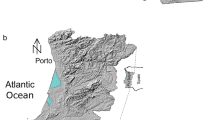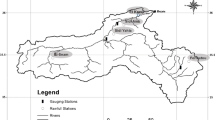Abstract
The first comprehensive use of wavelet methods to identify non-stationary time-frequency relations between North Atlantic ocean-atmosphere teleconnection patterns and groundwater levels is described. Long-term hydrogeological time series from three boreholes within different aquifers across the UK are analysed to identify statistically significant wavelet coherence between the North Atlantic Oscillation, East Atlantic pattern, and the Scandinavia pattern and monthly groundwater-level time series. Wavelet coherence measures the cross-correlation of two time series as a function of frequency, and can be interpreted as a correlation coefficient value. Results not only indicate that there are common statistically significant periods of multiannual-to-decadal wavelet coherence between the three teleconnection indices and groundwater levels in each of the boreholes, but they also show that there are periods when groundwater levels at individual boreholes show distinctly different patterns of significant wavelet coherence with respect to the teleconnection indices. The analyses presented demonstrate the value of wavelet methods in identifying the synchronization of groundwater-level dynamics by non-stationary climate variability on time scales that range from interannual to decadal or longer.
Résumé
La première utilisation exhaustive de la méthode des ondelettes pour identifier les relations non stationnaires dans le domaine fréquentiel entre les structures de téleconnection de l’Atlantique Nord tels que l’oscillation nord atlantique et les niveaux piézométriques est décrite. Les chroniques piézométriques long-terme de trois forages dans divers aquifères situés de part et d’autres du Royaume Uni sont analysées afin d’identifier de manière significative du point de vue statistique la cohérence des ondelettes des oscillations de l’océan Atlantique Nord, de la structure Est Atlantlque et de la Scandinavie, avec des chroniques piézométriques mensuelles. L’analyse de la cohérence des ondelettes indique la corrélation entre deux séries chronologiques dans le domaine fréquence et peut fournir un coefficient de corrélation. Les résultats mettent en évidence des périodes décennales à pluri-annuelles pour trois indices de structures de téléconnection et les niveaux piézométriques de chaque forage, mais montrent aussi qu’il y a des périodes où les niveaux piézométriques indiquent distinctement des différences de cohérence par rapport aux indices de téléconnection. Les analyses présentées démontrent la valeur de la méthode des ondelettes pour analyser la synchronisation des niveaux dynamiques de nappe dans des conditions climatiques variables pour des échelles de temps décennales, interannuelles ou plus longues.
Resumen
Se describe la primera utilización integral del método wavelet para identificar relaciones no estacionarias tiempo - frecuencia entre esquemas de teleconexión del océano Atlántico Norte - atmósfera- y los niveles de las aguas subterráneas. Se analizan series hidrogeológicas temporales de largo plazo a partir de tres pozos en diferentes acuíferos en el Reino Unido para identificar la coherencia del wavelet estadísticamente significativa entre las oscilaciones del océano Atlántico Norte, el esquema del Atlántico oriental y el esquema de Escandinavia y series temporales del nivel de las aguas subterráneas mensual. La coherencia del wavelet mide la correlación cruzada de dos series de temporales en función de la frecuencia y puede ser interpretada como un valor del coeficiente de correlación. Los resultados indican que hay períodos comunes estadísticamente significativos de coherencia de wavelet plurianuales a decenales entre los tres índices de teleconexión y los niveles de las aguas subterráneas en cada uno de los pozos, pero también muestra que hay períodos en que los niveles de las aguas subterráneas en pozos individuales muestran esquemas diferentes de coherencia de wavelet significativa con respecto a los índices de teleconexión. Los análisis presentados demuestran el valor del método wavelet para identificar la sincronización de la dinámica del nivel de las aguas subterráneas mediante la variabilidad climática no estacionaria a escalas temporales que van desde interanuales a decenales o mayores.
摘要
首次综合应用小波方法确定了地下水位与北大西洋海-气远程作用的非平稳时间-频率关系。为了确定北大西洋振荡、东大西洋模式、斯堪的纳维亚模式与地下水水位波动的逐月序列之间具有统计意义的小波相干性, 本文分析了取自英国境内不同含水层的三个井孔的长期水文地质时间序列。小波相干性表明两个时间序列的互相关性是频率的函数, 并可将其定量化为相关系数。结果表明, 多年乃至十年尺度上, 各个井孔的地下水水位都分别与上述三种遥相关指数存在具有统计意义上的小波相干性, 并且当个别井孔的地下水位表现出与涉及遥相关指数的重要小波相关性明显的不同模式。上述分析说明小波方法在不同尺度 (年际、数十年或者更长的时间) 下, 确定由非平稳气候变化驱动下的地下水水位同步变化研究上有较大价值。
Resumo
Descreve-se a primeira utilização abrangente de métodos de onduletas para identificar relações não estacionárias tempo-frequência entre os padrões de teleconexão oceano-atmosfera no Atlântico Norte e os níveis de água subterrânea. Analisam-se séries temporais hidrogeológicas de longo prazo de três furos dentro de aquíferos diferentes do Reino Unido para identificar coerências de onduletas estatisticamente significativas entre a Oscilação do Atlântico Norte, o padrão do Atlântico Oriental, o padrão da Escandinávia e as séries temporais mensais dos níveis de água subterrânea. A coerência de onduletas mede a correlação cruzada de duas séries temporais em função da frequência, e pode ser interpretada pelo valor de um coeficiente de correlação. Os resultados indicam que há períodos comuns multianuais a decenais, estatisticamente significativos, de coerência de onduletas entre os três índices de teleconexão e os níveis de água subterrânea em cada um dos furos, mas também mostra que existem períodos em que os níveis de água subterrânea nos furos individuais mostram distintamente padrões diferentes de coerências de onduletas significativos no que diz respeito aos índices de teleconexão. A análise apresentada demonstra o valor dos métodos de onduletas na identificação da sincronização da dinâmica dos níveis das águas subterrâneas por variabilidade climática não estacionária em escalas temporais desde interanuais até decenais ou mais longas.





Similar content being viewed by others
References
Allen DJ, Brewerton LJ, Coleby LM, Gibbs BR, Lewis MA, MacDonald AM, Wagstaff SJ, Williams AT (1997) The physical properties of major aquifers in England and Wales. British Geological Survey Technical Report WD/97/34, BGS, Keyworth, UK
Barker PA, Wilby RL, Borrows J (2004) A 200-year precipitation index for the central English Lake District. Hydrol Sci J 49:769–785
Blackburn M, Hoskins B (2001) The UK record-breaking wet Autumn 2000. UK Univ Global Atmos Modell Prog Newslett 24
Boggess A, Narcowich FJ (2001) A first course in wavelets with Fourier analysis. Prentice Hall, New York
Carmona R, Hwang WL, Torresani B (1998) Practical time-frequency analysis, vol 9: Gabor and wavelet transforms with an implementation in S (Wavelet analysis and its applications). Academic, San Diego
CPC (Climate Prediction Centre) (2010) Northern Hemisphere Teleconnection Patterns. CPC, Camp Springs, MD. http://www.cpc.noaa.gov/data/teledoc/telecontents.shtml. Cited 20 July 2010
CRU (Climatic Research Unit) (2010) North Atlantic Oscillation (NAO). CRU, Norwich, UK. http://www.cru.uea.ac.uk/cru/data/nao/. Cited 20 July 2010
Dickinson JE, Hanson RT, Ferre TPA et al (2004) Inferring time-varying recharge from inverse analysis of long-term water levels. Water Resour Res 40. doi:10.1029/2003WR002650, 15 p
Enfield DB, Mestas-Nuñez AM, Trimble PJ (2001) The Atlantic multidecadal oscillation and its relation to rainfall and river flows in the continental U.S. Geophys Res Lett 28(10):2077–2080
Farge M (1992) Wavelet transform and their application to turbulence. Ann Rev Fluid Mech 24:395–457
Ghil M, Allen RM, Dettinger MD, Ide K, Kondrashov D, Mann ME, Robertson A, Saunders A, Tian Y, Varadi F, Yiou P (2002) Advanced spectral methods for climatic time series. Rev Geophys 40(1):3.1–3.41
Grinsted A, Moore JC, Jevrejeva S (2004) Application of the cross wavelet transform and wavelet coherence to geophysical time series. Nonlinear Proc Geophys 11:561–566
Grinsted A, Moore JC, Jevrejeva S (2011) Cross wavelet and wavelet coherence. http://www.pol.ac.uk/home/research/waveletcoherence/. Cited 22 May 2011
Gurdak JJ, Hanson RT, McMahon PB et al (2007) Climate variability controls on unsaturated water and chemical movement, High Plains Aquifer, USA. Vadose Zone J 6:533–547
Gurdak JJ, Hanson RT, Green RT (2009) Effects of climate variability and change on groundwater resources of the United States. US Geol Surv Fact Sheet 2009–3074, 4 pp
Hannaford J, Marsh TJ (2008) High-flow and flood trends in a network of undisturbed catchments in, the UK. Int J Climat 28:1325–1338
Hanson RT, Newhouse MW, Dettinger MD (2004) A methodology to assess relations between climatic variability and variations in hydrologic time series in the southwestern United States. J Hydrol 287(1–4):252–269
Hanson RT, Dettinger MD, Newhouse MW (2006) Relations between climatic variability and hydrologic time series from four alluvial basins across the southwestern United States. Hydrogeol J 14(7):1122–1146
Henderson RD, Day-Lewis FD, Harvey CF (2009) Investigation of aquifer–estuary interaction using wavelet analysis of fiber-optic temperature data. Geophys Res Lett 36:L06403. doi:10.1029/2008GL036926
Holman IP, Rivas-Casado M, Howden NJK, Bloomfield JP, Williams AT (2009) Linking North Atlantic ocean-atmosphere teleconnection patterns and hydrogeological responses in temperate groundwater systems. Hydrol Proc 23:3123–3126
Hurrell JW (1995) Decadal trends in the North Atlantic Oscillation: regional temperatures and precipitation. Science 269:676–679
Jones IC, Banner JL (2003) Hydrogeologic and climatic influences on spatial and interannual, variation of recharge to a tropical karst island aquifer. Water Resour Res 39(9). doi:10.1029/2002WR001543
Jones PD, Jonsson T, Wheeler D (1997) Extension to the North Atlantic Oscillation using early instrumental pressure observations from Gibraltar and south-west Iceland. Int J Climatol 17:1433–1450
Luque-Espinar JA, Chica-Olmo M, Pardo-Iguzquiza E, Garcia-Soldado MJ (2008) Influence of climatological cycles on hydraulic heads across a Spanish Aquifer. J Hydrol 354:33–52
Mantua NJ, Hare SR (2002) The Pacific decadal oscillation. J Oceanog 58(1):35–44
Maraun D, Kurths J (2004) Cross wavelet analysis: significance testing and pitfalls. Nonlinear Proc Geophyss 11:505–514
Marsh TJ, Hannaford J (2008) UK Hydrometric Register. Hydrological data UK series. Centre for Ecology and Hydrology, Wallingford, UK, 210 pp
Meyer Y (1993) Wavelets and applications. Society for Industrial and Applied Mathematics, Philadelphia, PA
Milly PCD, Betancourt J, Falkenmark M, Hirsch RM, Kundzewicz ZW, Lettenmaier DP, Stouffer RJ (2008) Stationarity is dead: Whither water management? Science 319:573–574
Nason GP (2008) Wavelet methods in statistics with R. Springer, Heidelberg, Germany
Osborn TJ (2006) Recent variations in the winter North Atlantic Oscillation. Weather 61(12):353–355
Percival DB, Walden AT (2000) Wavelet methods for time series analysis. Cambridge University Press, Cambridge
Post E, Forchhammer MC (2002) Synchronization of animal population dynamics by large-scale climate. Nature 420(6912):168–171
Price M (1993) The Chalk as an aquifer. In: Downing RA, Price M, Jones GP (eds) The hydrogeology of the Chalk of North-West Europe. Oxford Science, Oxford, UK, pp 35–58
Qian BD, Saunders MA (2003) Summer UK temperature and its links to preceding Eurasian snow cover, North Atlantic SSTs, and the NAO. J Clim 16:4108–4120
Schroder TM, Rosbjerg D (2004) Groundwater recharge and capillary rise in a clayey catchment: modulation by topography and the Arctic Oscillation. Hydrol Earth Syst Sci 8:1090–1102
Slimani S, Massei N, Mesquita J et al (2009) Combined climatic and geological forcings on the spatio-temporal variability of piezometric levels in the chalk aquifer of Upper Normandy (France) at pluridecennal scale. Hydrogeol J 17:1823–1832
Stephenson DB, Pavan V, Collins M, Junge MM et al (2006) North Atlantic Oscillation response to transient greenhouse gas forcing and the impact on European winter climate: a CMIP2 multi-model assessment. Clim Dyn 27:401–420
Torrence C, Compo PG (1997) A practical guide to wavelet analysis. Bull Am Meteorol Soc 79(1):61–78
Walnut DF (2002) An introduction to wavelet analysis. Birkhauser, Basel, Switzerand
Acknowledgements
We acknowledge the British Geological Survey for provision of the groundwater level data. John Bloomfield publishes with the permission of the Executive Director, British Geological Survey (NERC). We thank Aslak Grinsted for making his wavelet coherence package freely available.
Author information
Authors and Affiliations
Corresponding author
Rights and permissions
About this article
Cite this article
Holman, I.P., Rivas-Casado, M., Bloomfield, J.P. et al. Identifying non-stationary groundwater level response to North Atlantic ocean-atmosphere teleconnection patterns using wavelet coherence. Hydrogeol J 19, 1269–1278 (2011). https://doi.org/10.1007/s10040-011-0755-9
Received:
Accepted:
Published:
Issue Date:
DOI: https://doi.org/10.1007/s10040-011-0755-9




